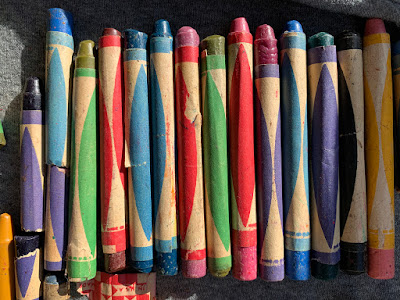Today I played with my childhood crayons for the last time. I know what you're thinking -- it's crazy that a person my age still has their childhood crayons. But when I emptied my mom's house I assumed that this pungent and evocative box of crayons would be something that everyone would want, so I saved them. I miscalculated by a longshot. Even I don't want them, but their power to plunge me into childhood is so awful and strong that I haven't been able to break the spell. Like the objects in the series Woke, this box of crayons taunts me from a shelf in the garage.
I decided that this is the day and that the only way I could divest of the crayons and keep the box was to pour them all out and review as a farewell. Ever the archivist.
What I learned:
- Crayola were considered the boss crayons for a reason.
- If you asked me in advance "What's your least favorite color of Crayola crayon?" the answer would have been Goldenrod. This is a) still true and b) you can tell that it was always the case because some of the longest crayons were Goldenrod, and there were a lot of them.
- Maize looks so much like Goldenrod that I question its purpose.
- I remembered correctly that most of the crayons in the ancestral box were a non-Crayola brand that had little color to offer. Blech.
- I did not recall that one brand of crayon was called "Little Artist', a name that I find sooooper patronizing.
- Guitar brand oil pastels are every bit as pleasing to use as I recall. They glide across paper in the most fluid and satisfying way.
- The Time Magazine pencil would have come from the inside of the magazine itself, I'm guessing. But we didn't subscribe to news magazines, so I'm not sure how it got in my crayon box.
- The name Prang, by Crayonex, gets points just for existing. But this solo, sturdy example in green was a nice crayon with lots of pigment to offer.




No comments:
Post a Comment